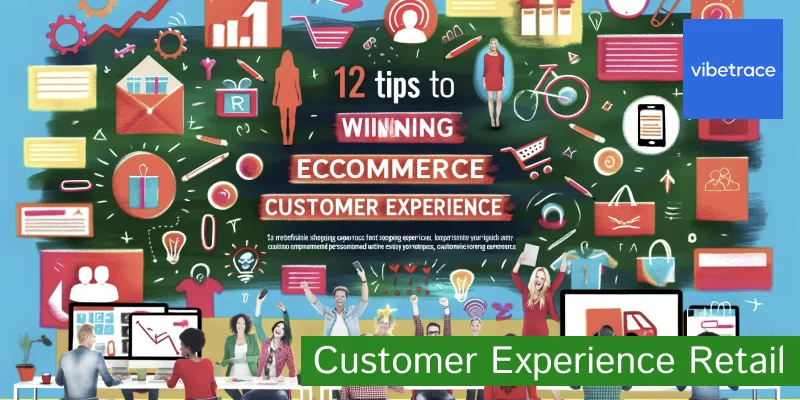The online shopping market has been growing steadily for years, but the COVID-19 pandemic has seen a huge shift towards this arena.
Where buyers were once resigned to the contents of their local high streets, they’re now able to tap into global markets, purchasing products from any brand that delivers the experience they’re looking for.
The balance of power has shifted away from brands towards customers, who have responded to the huge array of choices on offer, naturally, by demanding the very best.
In fact, customer experience for the top-ranked brand in each market is an average of 11% higher than its respective market average.
In 2021, it’s not enough to create a decent product range and expect online customers to flock to you. These days, consumers demand a quality experience across the board. Brands that don’t match this will quickly see themselves left behind.
In this guide, we’ll look at defining the ecommerce customer experience in practical terms and why it’s integral to factor a customer experience strategy into your marketing plans.
We’ll go into depth on ways to improve your own approach and the essential metrics to add to your key performance indicators (KPIs) to supercharge the customer experience.
Without further ado, let’s get going!
What is ecommerce customer experience?
The ecommerce customer experience is a term used to describe the service you provide to users at every touchpoint, considered from the customers’ perspective. This isn’t merely your customer service philosophy – it should encompass users’ impressions of your site and brand.
“Ecommerce isn’t the cherry on the cake. It’s the new cake.” Jean-Paul Agon, CEO, L’Oreal
By declaring ecommerce to be ‘the new cake’ back in 2016, Agon was unwittingly predicting the future. Plenty of us were already shopping online by that time, but digital sales were really viewed as just one channel within a brand’s overall sales strategy.
To take L’Oréal as an example, 6.5% of sales came from ecommerce in 2016. By 2020, that figure had risen to 26.6%.
The digital experience may still be seen as ‘just one channel’ but, should growth continue at such a rate, it won’t be long before it becomes the most important one of all.
With 76% of customers expecting brands they deal with to provide ecommerce services, delivering a high-quality ecommerce customer experience has never been more crucial.
When it comes to plotting your own ecommerce website’s customer experience, think about it in terms of interactions.
Everything from page appearance to content, high-quality images, videos, price points, ease of navigation, and after-sales support, contributes to the impression your site will make on potential customers.
Of course, the COVID-19 pandemic has also given us more reason to turn the cherry into an entire cake. Judging by the stats, things were already heading in that direction, but lockdowns and social distancing guidelines have certainly sped things along.
But don’t be intimidated. We’ll give you the recipe you need to make your ecommerce cake irresistible.
Ecommerce customer experience vs user experience
The terms ‘customer experience’ (CX) and ‘user experience’ (UX) are sometimes used interchangeably. In truth, these have separate definitions which just happen to overlap.
UX refers to the customers’ experience with your product or website, while CX encompasses the customers’ experience with your brand as a whole. So, UX is actually a component of your site’s CX, covering, for example, its navigation and usability. And CX includes much more, such as your site’s design, the emotions and thoughts it might trigger, interactions with your support team on a long-term cumulative basis.
So, where UX focuses entirely on the end-user, CX centres on the relationship between customers and a business.
You should develop your ecommerce strategy to create a mutually beneficial and sustainable customer/brand relationship so that customers keep returning because their needs are always met.
In both cases, it’s vital to strike a balance between the needs of the customer and your business.
Importance of customer experience in ecommerce
With over 80% of worldwide consumers making at least one online purchase in 2020, it’s safe to say that any business that wants to succeed needs to have a quality website. If potential customers visit a site and have a bad experience, they’re unlikely to make a purchase or return for a second glance.
A recent study showed that one in three people would leave a favoured brand after just a single bad experience. There’s little opportunity to get things right a second time. When it comes to ecommerce, love sadly doesn’t last forever.
By contrast, those who visit a site and have a positive experience are far more likely to buy and recommend a brand to their friends – 92% of consumers around the world trust word-of-mouth above all other forms of advertising.
Providing a good customer experience in ecommerce is essential to earning brand referrals and retaining customers – without either, your business simply won’t survive.
All of us have visited physical stores to make purchases in the past. Most of us will have expressed loyalty to a brand in the form of secondary or regular visits. It’s not just the product offering that inspires us to return, but the whole experience.
Maybe the layout is pleasing to the eye, making the browsing experience a stress-free delight. Perhaps the store assistants are friendly, knowledgeable, and helpful – while never following you around like a stray dog. Or maybe our frequent visits feel rewarded.
Any problems we may have with a product are dealt with promptly, we’re greeted with a friendly smile upon entry and are given special discounts throughout the year, especially on your birthday.
It’s these ‘beyond-product’ experiences that keep us returning to a certain physical store. The key to success in ecommerce lies in these same principles.
That’s why we created our Digital Assistant – to combine the traditional advantages of an in-store experience with the benefits of ecommerce. But more on that later.
What is ecommerce customer experience management?
Ecommerce customer experience management involves planning and executing the whole customer journey across your website.
This should encompass every potential interaction a customer might have with your brand online. Customer experience management can loosely be divided into three categories:
Pre-planning
As a first step, create customer personas. These are ‘character sheets’ that outline personality traits for each of your ideal customer types.
Personas should include personalised details about your customers, such as their age, gender, marital status, family size, financial position, interests, and geographical location. And there’ll be a few factors that are specific to your brand’s industry.
For example, if you’re running a shaving company, it may help to know if your potential customers actually have beards.
Later on, you can refine your customers into more specific groups, depending on their interactions with your site and the amount of money they spend with you. The online experience can then be tailored to meet specific needs and behavioural patterns.
On-page
The pre-planning stage should help inform your on-page offering, such as your content. What kind of content do your customers interact with best?
What questions do they need answering? Which social media platforms do they use?
If your products are quite technical, what level of understanding do they have prior to visiting your site? Should the tone of your site be straightforward or fun and conversational?

Although you should be creating customer persona-led content based on the data you have at your disposal, you can take this a step further with our Digital Assistant.
Let’s look at the example above. You’ve already considered your customer segments. Next, you’ve created content and a product range to match them. But not everyone knows precisely what they’re looking for.
Implementing our software helps to guide users to the products they need, just like a helpful, smiling, and knowledgeable store assistant.
As we’ll see in further detail below, the Digital Assistant adds a further layer of personalisation to the customer experience, saving them research-time and honing straight in on precisely what they’re looking for.
Off-page
This category should include customer support, newsletter/email content, feedback processes, customer loyalty programs, and how you manage data.
You’ll find a lot of overlap between these three categories. For example, data can help refine your customer persona profiles, and such changes will help you improve your content offering.
It’s important to remember that there’s no end when it comes to ecommerce customer experience management. Instead, think of it as a task that constantly needs re-visiting with new data and improvements.
What makes a good ecommerce customer experience?
The specifics of a good ecommerce customer experience will differ from one business or industry to the next – a lot depends on the type of customers you’re looking to attract. But there are a few considerations that are universal and relevant whether your users are 18 or 85.
Let’s break these into three categories:
Before
You only get one chance to make a first impression. So the customer experience should start before a customer is officially a customer.
Advertising is an obvious way to get your message across to people who haven’t yet visited your website. But consider all the places your brand can get coverage.
Maybe one of your products is being debated on a forum such as Quora or Reddit. Get in the comments section as a brand ambassador and join in with the debate. Perhaps you can have a look for posts on social media asking for a solution that your product provides.
Consider embracing social media yourself. Post info about and photos that highlight the advantages of your products or services while establishing a brand voice and identity that prospective customers will remember.
Could there be a trade fair where you can meet potential customers face-to-face?
These are all opportunities to provide a great experience for potential customers and bridge the gap between them and your website.
During
Once you’ve managed to get users onto your site, it’s really time to go to town. As we’ve mentioned, every potential touchpoint on your website contributes to providing a better customer experience, so make them all count. Match every expectation a customer may have.
Make the journey from homepage to checkout as clear, simple, and quick as possible. Be sure to offer a wide range of payment options, from debit and credit cards to the likes of PayPal.
Check out the above example from global swimwear brand Speedo. Despite a huge range of products, their ecommerce offering has been designed with simplicity in mind.
Above-the-fold on their homepage sits one eye-catching image, while the site’s navigation is as clear as crystal.
Essential information for both new and returning customers is also clearly displayed, such as a place to enter customer account details and their promise of next-day delivery. Nothing is cluttered, and the whole layout of the page is made appealing to users landing on the site.
Using Connected Media, you can make the customer journey on your site even easier to navigate. By asking direct user-intent questions based on browsing preferences through digital ads, ー or when users first land on your site using the Digital Assistant ーthe need for navigation can be completely eliminated.
Visitors only need to answer questions, and within a click or two, they’re on the product page of their desire.
After
A great ecommerce customer experience doesn’t necessarily end with a sale. Think of it as merely a first date in what you hope will be a long-lasting relationship.
Make sure your after-sales support is top-notch. Use the customer’s visit to help evaluate the performance of your site. Look at ways to tempt that customer to return to you. This could include seeking feedback, providing them with helpful information through newsletters, or giving them special offers.
A great post-purchase customer experience should make sure that customers stay up-to-date with your brand, giving them every reason to return for more.
Of course, not every visit can end with a sale, but support should still be given. Your analytics may show that a certain number of customers are engaging well with your website without resulting in a sale.
Let’s say they’re visiting a handful of pages in a logical order, even making it to checkout before exiting your site.
Our dedicated Email Remarketing tool can come in handy here by offering post-visit support. With the Swedish firm Cervera, we aimed to solve the exact scenario outlined above.
Want to be up to date with Marketing?
Subscribe to Marketing Automation dedicated newsletter!

Stay connected with what’s really important to optimize your digital revenues.
By clicking the button, you accept our Terms & Conditions. Also you will need to confirm your email address.
All users who abandoned their shopping baskets were sent a personalised email containing both their abandoned baskets as well as product recommendations based on their recent onsite activity.
Such a personal approach resulted in feedback, which allowed the brand to make changes to its checkout procedure – in this case, the cause of checkout abandonment. Ultimately, this approach served to increase the average order value among those customers who had initially left the site at this late stage.
This case study perfectly indicates the need to keep the customer experience alive, even after users have left your site.
Tips on improving ecommerce customer experience
Customers are no longer limited to what they can find on their local high street. They want every touchpoint with a brand to deliver a great experience, safe in the knowledge that, should one brand fail them, there’s another that will more than live up to their demands.
Take Amazon’s approach, for example. A huge number of their products are available at different price points from different suppliers. Some will be brand new, others secondhand.
Perhaps the cheapest version of the product comes with the longest delivery time. Either way, customers are offered choices, and the ball is firmly in their court, not in the hands of the brand.
In another world, supermarket brand Tesco seeks to personalise the customer experience and to make online food shopping as smooth and easy as possible.
Users are presented with a pop-up of recently-purchased items, meaning they can kick-start their shopping basket without the need for laborious searching.
These two examples show carefully thought-out methods of making the customer experience more pleasurable, and you can do the same. We believe the following are the most effective techniques to improve your own brand’s CX and add the wow factor to every possible user interaction in 2021.
Optimise mobile experience
The use of mobile devices to both browse the internet and make purchases has grown hugely over recent years. A study by Statista showed mobile phones accounted for 54.8% of global website traffic during the first quarter of 2021.
Your mobile site needs to be just as tasty as your desktop one. Consider using accelerated mobile pages (AMP), conduct a full technical audit with a focus on speed, and check all your pages for usability.
Switch to an omnichannel approach
‘Omnichannel’ has surpassed ‘multichannel’ as an ultimate philosophy for providing a great customer experience. Whereas a multichannel approach offers a wide range of channels for customers to use, an omnichannel service ensures a united experience so that each channel delivers the same high-quality as the rest.
If a customer prefers to contact your business via SMS, social media, or email, they should expect to receive the same level of service they’ll get when making a phone call to your customer service department.
Customers should also be able to switch between channels at will – making a call first, then following it up with an email, for example – without any drop in the level of service they receive and with customer service reps armed with all the information supplied by customers across every channel of contact.
Provide appealing product pages & description
When it comes to product pages and descriptions, there are two main considerations. One is to appeal to a customer’s emotions by writing heart-stirring, tantalising content that makes them reach for the ‘Buy Now’ button.
The other is to answer any potential questions they may have prior to purchase. With more technical products, it’s worth considering the value of product demo videos.
Given that prospective customers can’t try out a product as they would in-store, your product images and information should try to emulate a physical experience as closely as possible.
The above image gives a great example of supplying all the necessary information customers require at-a-glance. The wider page includes several shots of the product in question from all angles.
Even fit information is offered in detail, along with other helpful info and matching pieces to encourage further purchases.
Streamline checkout process
Checkout should be easy, fast, and offer a variety of payment options. You should be able to draw up a list of preferred methods from your customer personas, and these can be refined using customer feedback and analytics over time.
Make sure it’s up to date. Nobody uses postal orders these days. And if they do, they probably don’t shop online.
Consider offering benefits to customers who set up an account and subscription services to make future checkouts even faster.
Ensure your security credentials are made clear, that there are no hidden charges, timescales are shown at the point of purchase, and a confirmation email is sent. You should also make it easy for customers to change their order if they wish.
By implementing our Digital Assistant, you can elevate the buying experience for your customers. Using behavioural cues, we offer a range of solutions to encourage visitors to complete a purchase, including tailored content, targeted messaging and recommendations based on previous site interactions.
Such functionalities provide users with a host of different incentives to make them think twice about abandoning their shopping cart and even add more products to it.
Provide proactive customer support
If customers have a problem, this needs to be treated with the utmost seriousness. Your customer service agents must be well-trained, equipped with quality equipment and software, and well-paid.
Don’t expect an agent to care about your brand – or your customers – if they’re receiving a paltry pay packet at the end of each month.
Proactive support means you shouldn’t just wait for customers to come to you. By providing good after-sales service through seeking feedback and follow-up emails, you may be able to nip potential problems in the bud before they germinate.
Offer fast and free shipping
With 66% of potential customers prepared to leave a brand that doesn’t offer flexible shipping options, it’s essential to give this area some serious consideration.
You could decide to make all shipping free (and your product prices slightly higher). Or match varied delivery timescales with costs. This gives customers the ultimate decision on how much they’re willing to pay according to how desperate they are to receive a product.
Make sure any ‘non-product’ fees are made clear from the very start of your purchasing procedure.
Engage with customers across channels
There’s a myriad of communication channels available these days. Make sure you use as many as possible and take advantage of analytics to find out which platforms your customers use the most.
“You can’t just open a website and expect people to flood in. If you really want to succeed you have to create traffic.” Joel Anderson, CEO, Walmart
Build relationships across social media channels, keep an eye on industry forums, and react to comments from customers.
Look out for the latest social media crazes and give your brand a presence as soon as possible. Use these channels to drive traffic to the relevant pages on your ecommerce site.
Design user-friendly website
The hub of an ecommerce business is its website. Make sure yours looks fabulous, is full of valuable information that your customers are looking for, and is easy to navigate.
Your ultimate aim is to attract users to your website to make a sale. If your site is too slow and poorly designed, they’re unlikely to hang around and even less likely to return in the future.
By recreating an in-store experience online, our Digital Assistant instantly makes a website more user-friendly. Let’s look at the case of German IT experts AfB, who utilised Marketing Automation software to create a better targeting strategy.
This led customers to what they wanted and needed in the fastest and most convenient way possible.
Our Digital Assistant tracked user behaviour to create a tailored, non-obtrusive experience for every customer that visits the AfB site, making it more user-friendly and allowing for seamless navigation.
Compare it to visiting a physical store and being met at the door by an expert assistant, who then proceeds to answer all of your questions while leading you to the part of the store that houses the exact products you desire. That’s our Digital Assistant in a nutshell.
Create personalised experience
Personalisation is invaluable when it comes to providing a great customer experience. In fact, it’s the strongest pillar in driving customer loyalty in 19 of the 27 global markets.
As a general rule, your customer personas should help you create content that matches the needs and expectations of your potential customers.
Once you know your customer better, you’ll be able to target them through more personalised offers, emails, and the social media platforms that they prefer.
Personalisation can actually begin before users reach your site by using our Connected Media.
Whether you’re looking to expand upon your customer base or tempt previous customers to return, Vibetrace can create tailored, high-impact ads to bridge the gap between advertising and your own website.
Based on previous user activity, ads may include personalised offers or a range of speedy questions geared towards finding precisely what a customer is looking for. Such an approach can help to reduce your digital marketing spend and yield a greater return on investment (ROI).
Offer valuable content
Content needs to answer as many user questions as possible. If a potential customer can’t find the information they need on your site, they’ll simply go looking elsewhere. Your content also needs to be aspirational.
Even the most amazing product won’t sell if its related info sounds like it was written by Eeyore.
Finally, make sure you pay attention to the nitty-gritty. If a product is sold out, make sure that’s clear, and offer alternative products or a timescale of when it’ll be next available. If your content offers value, users will return again and again.
Build a community
One Facebook post per week won’t cut it these days. Brands need to engage on as many social media platforms as possible and grow their army of followers through newsletters and by attending to industry forums.
Remember, different platforms provide different opportunities for your brand to show its personality and potentially open the doors to new types of customers.
No matter how large or small the industry your own brand resides in, there’ll always be new, fresh competition just around the corner. Remember, you’re all competing for the same customers, so it’s essential to diversify in an attempt to make your own company stand out.
Building a community across a variety of platforms enables you to engage directly with your customers, get to know them better, earn their trust, and wow them with your own wonderful personality.

It can take time to do this, but brands can earn customers through more ways than just their product range.
One example of a brand that’s built its image by sharing its personality and what it believes in is Ben & Jerry’s ice cream.
Standing up for equality in racial, gender, LGBTQ+, and refugee rights as well as climate change, the brand launched a new flavour named Pecan Resist and donated all profits to organisations supporting human dignity and justice.
By making its own ideological values clear, Ben & Jerry immediately stood out from its competitors and widened its appeal. The brand is no longer famed for its ice cream but for its social justice beliefs too.
Of course, brands should always tread carefully when it comes to social justice campaigns and avoid jumping on the latest bandwagon at all times.
But when an issue comes along that’s 100% in line with a company’s core beliefs, it provides a unique opportunity for brands to interact with both existing and potential customers.
Intelligent search
Machines are not ready to take over just yet, but they can truly help ecommerce companies provide a wonderful customer experience.
Google has long been using intelligent search to deliver better results, and brands should take advantage of this.
Registering with Google My Business and adopting Schema-tagging can significantly increase your chances of appearing in featured snippets, giving your brand a much greater presence when it comes to search results.
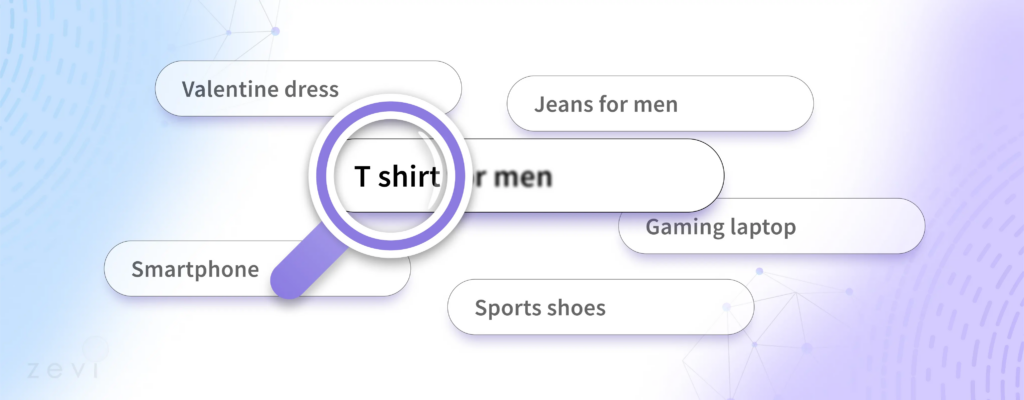
Above, we can see the Google My Business results for the French clothing brand Lacoste. As well as providing some basic details about the company, the listing dominates the search engine results and also contains links to social media.
Simple tactics such as making sure your own brand is listed can greatly increase its online presence. Also keep track of sessions with search to see how you can push more visitors to use search.
Best practices
Providing a great ecommerce customer experience involves a lot of work. As we’ve seen, CX includes every potential touchpoint a customer could have with your brand.
As this could run into hundreds of areas, any business leader or marketer could easily end up in a padded cell trying to micromanage every individual facet.
To keep your head, it’s best to break these down into manageable chunks, as we’ve done below.
Be customer-centric
Customers are the ones in charge these days, and it’s up to you to find out what they want and then deliver it. From creating customer personas to using feedback surveys and analytics, you can use your findings to influence all of your future marketing.
Being customer-centric should sit at the heart of your entire ecommerce customer experience strategy. Our Digital Assistant enables you to achieve this through specific messaging and offers.
As we’ll see in the example below, we can help a brand identify pivotal moments where ‘micro-narrative’ messaging can better meet customer needs compared with a blanket approach.
The difference here is that a ‘micro’ message is user-specific – the opposite being a huge TV commercial geared towards a much larger audience.

As a result, customers are more quickly connected to the solutions or products they’re looking for, resulting in a premium shopping experience and a higher conversion rate.
If a specific customer or segment is more likely to convert when there’s an instalment plan available, then that’s precisely the offer they’ll be presented with.
Ask and listen to your customers
If you want to know what your customers want and how they’re feeling, ask them. You should develop a variety of surveys aimed at sourcing feedback across different aspects of your business.
Some could be website-focused, others relating to your product range. Maybe you can gather insights on how your brand is perceived and whether the answers match your intentions.
Be sure to act upon your customers’ insights. We all like to have our voices heard, and brands that respond to feedback enhance their trust factor and are more likely to keep hold of their customer base.
Vibetrace Platform offers polls and surveys you can use to collect visitor data but also use results in segmentation.
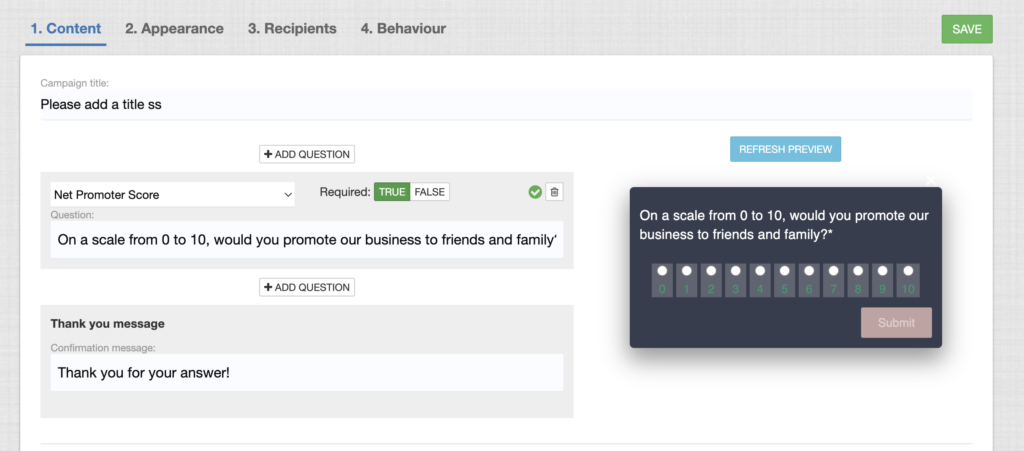
We create surveys based on the insights we’ve previously gathered from visitor behaviour on your site. It’s all very well to bombard your customers with a generic list of questions from time to time.
But, your brand will receive more valuable data if the questions asked line up with the browsing and shopping tendencies of a particular user.
Highly-targeted surveys can be aligned with the goals of your company, give customers more of a chance to have their say, and provide accurate data that can be used to influence future marketing strategies.
Know your customer journey
Your website’s customer journey needs to be easy to follow. As we’ve established, you must know your different customer segments and the various stages of your sales funnel inside out.
At each point of the funnel, it needs to be clear to customers how they can progress to the next stage. And your site needs to work hard to provide everything a customer needs in order to make that step.
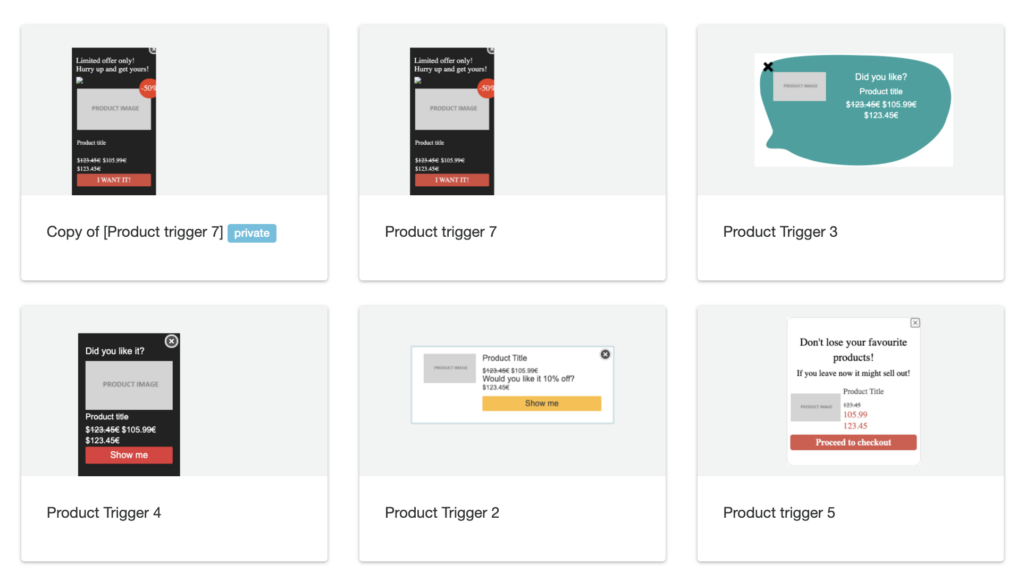
Our Digital Assistant can be set up with dynamic messaging to help keep customers on the right path.
With pop-up panels looking to engage and prevent them from daydreaming or wandering down a rabbit hole like Alice, we’ll help customers to remember why they landed on your site in the first place.
Even those who get distracted at the checkout stage can be encouraged to complete their purchase.
Our software can automatically save all abandoned baskets before sending them through email, so customers have a second opportunity to complete their order at a time most convenient to them.
Optimise supply chain
Mismanagement of your supply chain – the route from your product manufacturing to your customer’s doorstep – is a guaranteed way of displeasing customers.
You need to consider your stock levels and timescales alongside customer demands and expectations.
This has become ever more important during the global pandemic, forcing more businesses to go ecommerce-only and placing new demands on the whole supply chain.
Every step of the chain needs a regular audit. If you use warehouses to hold your stock, can they be situated in the heart of your customer base?
Can you find different shippers offering the same service at reduced costs? What procedures do you have in place to soften the blow for customers whose products arrive late?
Ask such questions of your supply chain regularly and make the necessary improvements as soon as possible. All it takes is for one measly parcel to be late or go astray, and a once-loyal customer can quickly develop a wandering eye.
Optimise customer fulfilment process
The customer fulfilment process concerns the final stages of a sale, from ordering a product to it arriving on their doorstep. It should also cover your returns policy.
We’ve discussed the importance of transparency when it comes to your checkout pages, and any claims your site makes regarding timescales should be strictly adhered to.
You also need to plan solutions to different eventualities. For example, where should the product be left if a customer has to go out? Is it possible to state a specific delivery time?
Likewise, your returns policy should be transparent and make it as easy and cheap as possible for customers to send products back. As well as providing quick refunds, you could offer alternative products.
That way, instead of losing a sale and giving a refund, a customer may buy something else instead.
Or, if you have a physical store, allow customers to return their unwanted product there, saving them postage costs.
How can we help you achieve customer experience success?
It’s our goal to create an effortless customer experience for every single visitor to your website. We do this by supporting customers throughout their user journey, discovering their needs and preferences, and guiding them to the most relevant product that suits their needs.
Online shopping has it’s real benefits like convenience, choice, and savings. But it’s hard to beat in-store retailers for their helpfulness, friendliness, and personalised attention. That’s what we can achieve for sites through the Digital Assistant.
Digital Assistant helps to deliver important outcomes for your customers in 3 key areas
Personalisation
‘Personalisation’ has long been a marketing buzzword, and with good reason. The more personal an experience for a potential customer, the more they’re likely to invest in your product or service. In fact, 91% of customers are more likely to shop with brands that provide offers and recommendations that are relevant to them.
We’ve discussed the value of creating customer personas and using these to shape and inspire the content you produce. Our Digital Assistant allows you to take this a step further.
Our smart campaigns serve up a series of quick questions to uncover the customer’s intent. Even if your site is well organised with good navigation, it’ll save users the need to browse.
Our Digital Assistant grows more knowledgeable with every visit, taking note of the content they visit and any purchases made.
Over time, we will be able to serve up tailored experiences, using data gained from past visits to shape the customer’s experience every time they land on your site.
Optimisation
We’ve looked at optimising your content offering to attract more users to your site and keep them there. But once you’ve pushed optimisation to the max, all you can do is keep a watchful eye on your analytics and then make refinements depending on what the results look like.
Our Digital Assistant makes your optimised site work even harder. With targeted messaging and product recommendations generated by users’ previous onsite activity, you won’t just have an optimised website – each user experience will be optimised as well.
Personalise visits, and you’ll also be able to take the real-time data gained from such interactions to inform your future marketing plans. And you’ll be able to align these with your customer profiles more accurately than ever before.
Guided selling
Guided selling aims to recreate a retail store experience online. Let’s imagine going into a favourite clothing store. Everything is laid out in an organised way, sectioned by age group, gender, and garments.
It’s easy to see what you’re after, and good store assistants will be on hand to guide you to the right place if you can’t immediately see that pair of purple socks that your heart so desires.
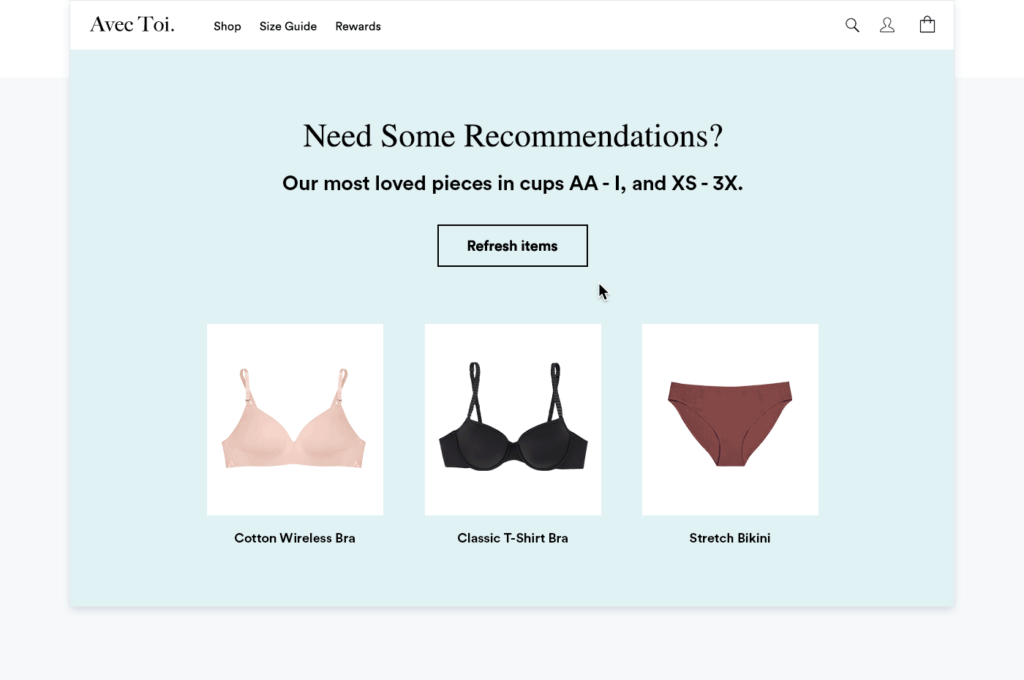
Our Digital Assistant simulates this by asking a series of questions when users land on your site. Potential customers are then guided to the products they’re seeking in a matter of clicks.
There’s no need to go browsing or even utilise your site’s search bar. It’s just like having a store assistant on call, answering your every question.
Make the customer experience feel tailored for the individual
Expanding on the importance of personalisation, our tools serve to make every customer experience tailored to the individual. To see how this works in practice, let’s take a look at our Smallable case study.
We built a comprehensive site map for the brand, heavily influenced by their customer personas.
Do you like this article?
Join Mary and the Marketing Automation dedicated newsletter!

Stay connected to what’s really important to optimize your digital revenues.
By clicking the button, you accept our Terms & Conditions. Also you will need to confirm your email address.
Different users were then served tailored messages upon visiting the site, with personalised product recommendations based on browsing behaviour. This looked at other brands that users had shown an interest in.
Such dynamic messaging provided a massive boost to both engagement and conversion rates. These new additions blend in perfectly with the tone and layout of the brand’s existing website and simply offer users a more tailored experience.
Metrics you should keep your eye on
Providing an excellent ecommerce customer experience can deliver a great return on investment. But how can you manage this?
If your business is making a profit and your online sales are high, it’s highly likely that you’re doing something right. But it’s worth keeping an eye on some key performance indicators (KPIs) to determine the areas where your business is performing, and those where improvements are required. We’ll cover the main ones below.
Customer data
‘Customer data’ isn’t a metric – it’s a collection of metrics that you can monitor through any analytics platform. These include page views, time on page, bounce rates, devices used, and how users found your website (e.g., through a search engine, an ad, or directly).
It should also cover the financial side of your relationship, which we’ll look at in greater detail below.
Keeping an eye on these metrics will help you see where your ecommerce experience is succeeding and the areas on your website in need of improvement.
As your business matures and you’ve managed to grow a returning customer base, you can keep checks on individual customers and customer segments.
If they suddenly stop buying from you, you must uncover the possible reasons for this and make changes to your site or marketing approach.
“Consumer data will be the biggest differentiator in the next two to three years. Whoever unlocks the reams of data and uses it strategically will win.” Angela Ahrendts, Senior VP of Retail, Apple
Remember, it’s not enough simply to collect a host of data. Make sure you’re collecting the relevant data for your particular business and industry. Ensure you understand it and can use your findings to make changes that will have a positive impact on your business.
Keep abreast of the latest developments and be prepared to make changes to your data approach, depending on customer trends and world events.
Lifetime value
‘Lifetime value’ is an estimate of the amount of money your average customer is likely to spend on your brand. To make this calculation, multiply your average spend value by your average spend frequency rate. Then, multiply this figure by your average customer lifespan.
This is a figure that you should recalculate regularly. Every time your business grows, the number should grow with it, and you’ll need to factor this in when it comes to your sales estimations and stock levels.
For more accurate figures, it’s worth calculating lifetime value per customer segment. You could, for example, then divide your customer groupings into big spenders, medium spenders, and low spenders.
Each group can then be targeted with personalised offers through email remarketing and newsletters that are better suited to their own overall spend and frequency.
Retention cost
‘Retention cost’ tells you how much you’re spending to retain your customers. Retention spend will usually include all the money you’ve spent on marketing, from the cost of your ads to your website, social media posts, and email newsletters.
To make this calculation, divide your customer retention costs for year A by the number of returning customers from year B (the following year).
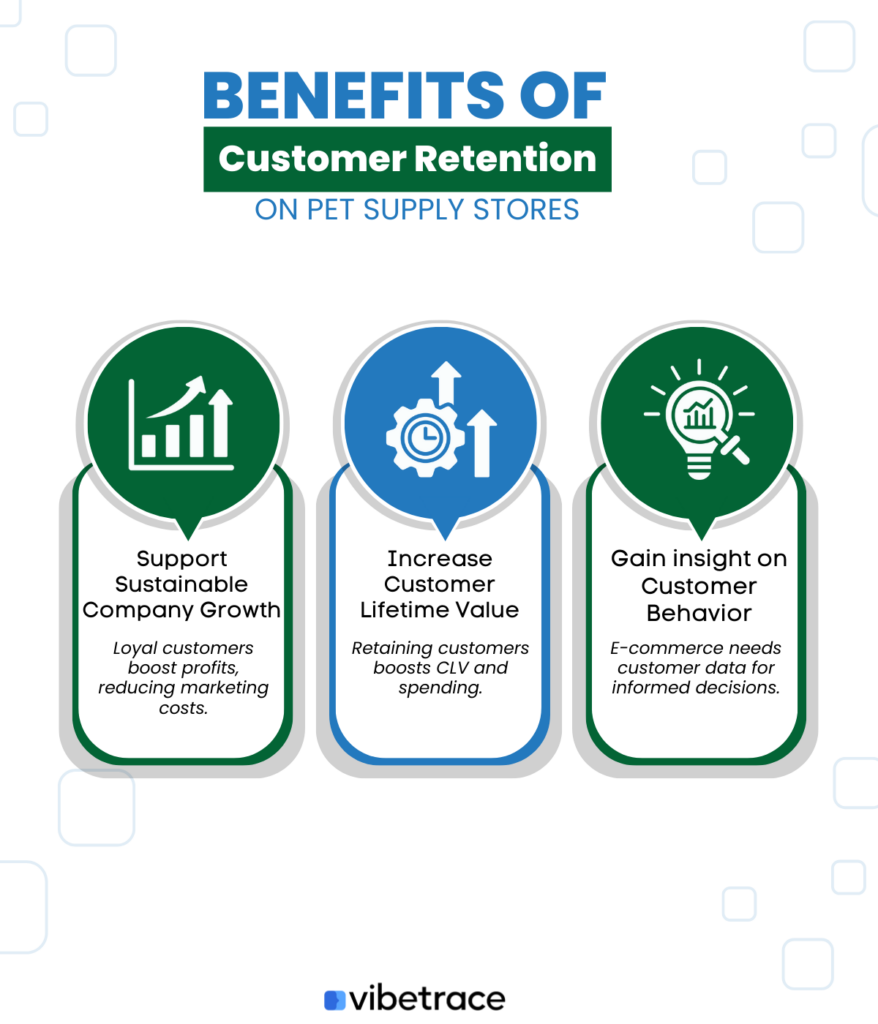
If the result is a minus figure, then you’re spending more on each customer than they’re actually spending on your business.
You’ll need to look at every aspect of your marketing budget, see where the biggest conversions are coming from, and then pull back your spend in the areas that have the least effect on sales.
Website performance
Monitor performance on a weekly basis and act on your findings. Look at traffic, number of page sessions, bounce rates, exit rates, conversion rates, and compare these figures year on year.
Look for positive and negative patterns that emerge and use the data to work out why they’re happening. Never make assumptions, no matter how experienced you are.
Keep an eye on your competitor’s websites as well. You may not be able to draw on the same level of data insights but using SEMRush or AHRefs, you’ll be able to analyse the content quality and successes of your competitors. From this, you can identify content gaps on your own site and any offers and promotions that you can learn from.
The value of monitoring website performance can be seen in our case study with Claire’s. The international brand offers a range of on-trend and quirky jewellery and has a major high street presence.
We learned that a significant issue with their website performance was a high bounce rate on their site’s basket and checkout pages.
Using this valuable data, we built a solution using our Digital Assistant. Firstly, we introduced promotional messaging on those two pages that suffered from high bounce rates.
The result?
An impressive 4,909 clicks over the next three months. Secondly, following extensive product development, this number rose to over 30,000, prompting us to expand the campaign to the brand’s ear-piercing page, boosting earring sales.
We used user information from browsing history and recommended products alongside promotional messaging to keep visitors to Claire’s website engaged.
The brand’s average order value (AOV) rose from £24.60 to £25.68. And the whole project started because of a brand keeping a close eye on its website’s performance.
Customer satisfaction
Top levels of customer satisfaction should be sought across your business. Product reviews and order satisfaction surveys should follow all purchases as standard.
You can introduce feedback surveys whenever customers have contacted your service department.
It’s also handy for businesses to seek more specific feedback at various points throughout the year. These may include questions concerning your website’s usability, areas of your business customers would like to improve upon, or your product offering.
To encourage loyal customers to fill in longer surveys, it’s worth offering a sweetener (‘10% off your next order!’) or using replies as entry forms in a competition to win a free product.
Make customer satisfaction a leading goal for your business. Get this right, and you’re likely to see improvements across all of your specific metrics, such as traffic figures and conversion rates.
How to measure and monitor your customer experience
If your business is thriving- taking on more employees, growing its customer base, and funding your uber luxe lifestyle, it’s definitely time for a pat on the back.
But make it a little one. All experienced marketers will know that customers are a fickle bunch, easily swayed by the lure of bright lights and a rival’s special offers.
Remember, the customer experience is all about your customers’ overall impression of your brand, so it’s important not to get complacent. Your business needs to keep up appearances.
If you can keep up with your customer’s thoughts and feelings, you’ll be able to adapt your brand to whatever they need and keep your relationship alive. Here are some critical calculations to keep that flame burning brightly.
Customer satisfaction rate
To measure your customer satisfaction rate, you’ll need to ask customers for feedback every time they have a direct interaction with your business. This may include a purchase or call with your customer service department.
It’s surprising how difficult it can be to tempt customers into filling out surveys, so make them as straightforward as you can. Now, using customer surveys you really zoom in and personalise questions that are specific to a customer’s interactions with your brand, but let’s start with the basics:
‘How satisfied are you with the service you received today?’
You can then give a list of, say, five options from ‘very satisfied’ to ‘very dissatisfied’.

To calculate your satisfaction rate, divide the number of ‘very satisfied’ customers by the number of customers who’ve filled out your survey, then multiply by 100.
(Satisfied customers/number of customer) x 100= customer satisfaction rate
The higher the number, the better! But, unless the figure is at 100%, there’s still work to be done.
It’s impossible to please everyone, and some people are just too grumpy to give credit where credit is due. But there could be genuine reasons behind many of your customers’ lack of satisfaction, and it’s well worth trying to find out what these are. As well as giving out a multiple-choice questionnaire as mentioned above, include a comments box so your dissatisfied customers can explain their grievances to you.
Net promoter score (NPS)
Your net promoter score (NPS) is an estimate of the number of customers who would recommend your business – and hence do some valuable marketing for you, on the cheap.
As with calculating your customer satisfaction rate, simply survey a question along the following lines:
‘How likely are you to recommend (brand name) to your friends?’
Offer five answers, from ‘very likely’ to ‘very unlikely’.
From here, you’ll need to make three calculations. But don’t worry, it’s easy-peasy.
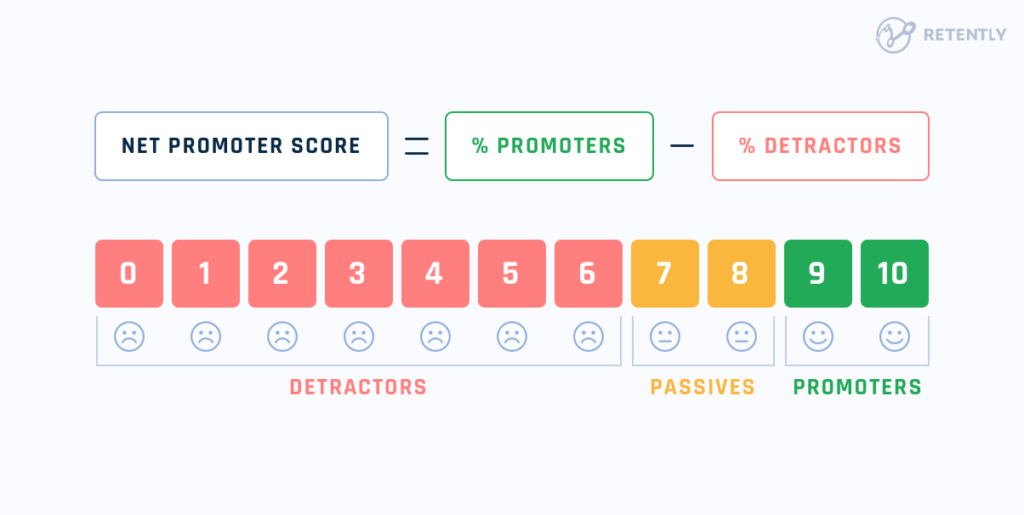
1) (Very likely customers/number of customers) x 100= % of customers who would recommend your brand
2) (Very unlikely customers/number of customers) x 100= % of customers who would NOT recommend your brand
3) (Very likely % – very unlikely %) x 100= NPS
Customer effort score (CES)
Your customer effort score is specifically related to your online store and so an invaluable metric when it comes to measuring the quality of your ecommerce customer experience. When surveying, ask a question along the following lines:
‘How easy do you find our website to use?’
Offer five answers from ‘very easy’ to ‘very difficult.’
Work out your CES by making the following calculation:
(Very easy customers/total number of customers) x 100= customer effort score
Don’t forget to include a feedback box on your survey, so customers can give specific reasons why they find it very difficult, or, hopefully, very easy.
Conclusion
In February 2021, 71% of UK consumers admitted to shopping more online than ever before. And with high streets around the world having been hit hard by the ‘new normal’ of staying at home, the trend towards internet purchases looks set to continue.
This makes providing a winning ecommerce customer experience more essential than ever before. Brands can no longer afford to rely on their brick-and-mortar stores to wow their customers.
A greater understanding of online consumption is needed, combined with an ongoing dedication to meet user needs across all digital touchpoints.
In 2021, brands can no longer create websites merely as a complement to their physical stores. Brands need to transform their sites into virtual shops that replicate the in-store user experience online. Contact us today and see the unique difference we can make to your own organisation.
Frequently Asked Questions (FAQs)
What is ecommerce customer experience?
Ecommerce customer experience describes the overall service you provide to users of your website. Ecommerce brands should include usability, as well as the feelings your website evokes and the way your brand comes across. Every single interaction your customers have with your site – from appearance to content, checkout, and support – contributes to the customer experience.
What makes a good ecommerce customer experience?
Your site should look appealing and inspire users to want to be part of your brand and wider community. Your content should be valuable and engaging.
Your product pages need to answer questions and provide the equivalent to an in-store experience throughout.
Your site should be responsive and technically sound. Navigation should be clear and easy. And you should offer customer support through a range of channels.
Why does ecommerce customer experience matter?
Delivering a quality ecommerce customer experience is crucial to your bottom line. A positive experience increases the chance of sales, hence helping you to earn, retain and grow your customer base.
Users are more likely to recommend you to their friends, providing free marketing services.
Offer poor service and an unhelpful ecommerce site, and your selling potential will dwindle. In short, the customer experience can either make or break a business.

